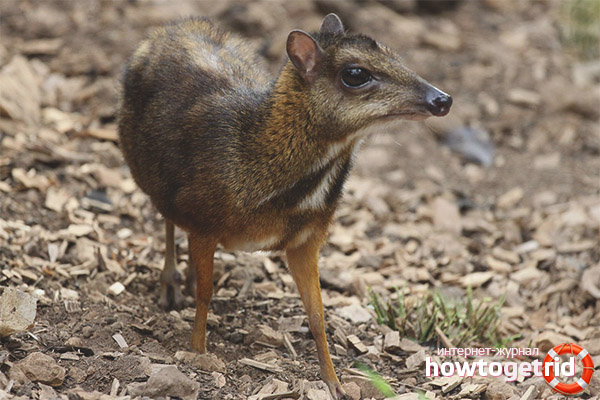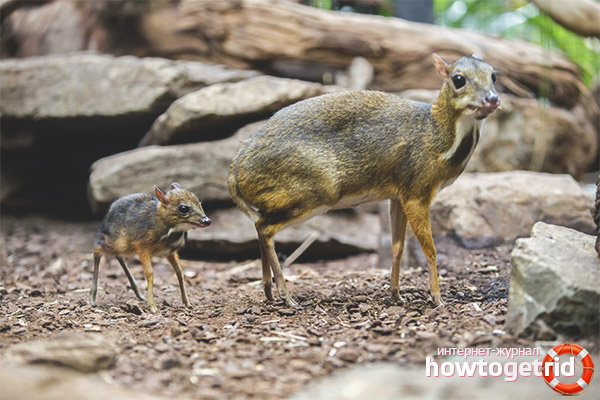The content of the article
There are a lot of unique and strange animals on planet Earth, the average man in the street has not even heard about them and does not know about their existence. But this beast has surpassed all existing in the world. Kanchil is a tiny vertebrate animal, which is representative of the deer squad. Archaeologists say that the very first representatives of this genus lived fifty million years ago in the Miocene era. To date, modern Kanchil practically does not differ externally from previous generations, even the behavior remains the same.
Habitats
The smallest animal prefers hot and warm countries, and seeks to live closer to the equator. It can be found only in West Africa and Southeast Asia, you will not see this miracle anywhere else. Today, the family of artiodactyls has five species, four of them are best studied.Memin, or as he is also called spotted kanchil, lives in India, and can also be found on the island of Ceylon. A larger animal of this genus can be seen on the island of Sumatra.
The smallest deer settled in southern China. All members of the family look very similar to each other, and only slightly differ in some specific features.
Description of the species
The largest representative of the kanchili is the water fawn, it has a body length of 75 - 85 centimeters. For comparison: the smallest deer grows up to 55 centimeters, and its growth is about 20-25cm, the weight reaches two kilograms on average.
The animal's body shape is rounded, almost like a barrel, with a fairly dense physique, the back is arcuate, and the legs are very slender and thin, like a real deer. On the legs there are four hooves, and there is another distinctive feature - the side hooves are much smaller than the average ones. The neck is rather short, the head with a narrow elongated muzzle and very large black eyes, pointed ears. In contrast to the deer, these horns do not grow at all in such tiny animals, despite such a loud name. Males differ from females by sharp and large saber-toothed canines on the upper jaw, they bulge out, even in the case when the animal's mouth is completely closed. The coat color is brown or brown with light specks, it can often have an orange tint.
Lifestyle
Kanchil leads a rather strange way of life.These animals are very shy and live covertly in the wilderness, trying not to get out of it anywhere. They feel most secure in dense forests, where there is tall grass and a huge variety of shrubs. During the daytime, small deer usually sleep in the gorges of rocks, empty tree trunks or hollows abandoned by previous owners, but at night they leave their shelters giving protection and go in search of food. Usually they go in search of food as soon as the sun goes down and darkness comes.
Often they lay long paths, creating a tunnel among impassable thickets. These strange animals feed on fruits, buds and leaves. A distinctive feature of this "little deer" is its excellent ability to fish. Therefore, Kanchil is deservedly considered an excellent fisherman.
Comfortable most of all this strange unusual animals is among the impenetrable thickets, as long as there is a reservoir next to it. For example, for the African deer, water is very necessary, because in some cases it is the only way to escape from predatory animals.When Kanchil feels in danger, he just dives into the water and goes further in search of shelter. She can do very well for some time without air, which often saves his life. And besides, he spends most of his life in it, while looking for food in the same place.
Although these small deer go on their hooves, they somehow manage to conquer trees, which they gladly pluck and eat ripe fruits. There have been many cases when a deer, hiding from enemies, climbs into the trees. Everyone knows that most ungulates sleep mostly while standing, but this is not about our little animal, it sleeps lying down, bending its thin legs under itself.
What eats?
Almost everything that comes along the road is eaten - they will devour the leaves of any plant, tear off the fruits and extract the seeds, do not pass by any fungi. As aquatic animals, algae can also be eaten quite often, which is typical for representatives of this species. In the background, they prefer different insects and small rodents as food. They love to fish in a variety of reservoirs - streams, small rivers, lakes, ponds.Olenki who live in Africa devotes a lot of time to water. She is not only looking for food in her, being an excellent swimmer, but also uses the water surface as a shelter for predators. eat crabs and fish.
Breeding
Small deer are polygamous animals, they live alone, not gathering in flocks, and are found only for breeding. The mating period for these deer unaccustomed to the human eye lasts only a month - from June to July. Like other animals, there are often fights for the female, especially since kanchili have sharp and long canines.
Females spend most of their life pregnant, because the baby is about five months old, or more precisely, 150-160 days. A surprising feature of the presented animal is that the females are literally a couple of hours after birth, ready for a new mating. For twelve months, a deer can produce two to three offspring. Usually one deer is born, only Asian Kanchils are born twins. Born cub perfectly keeps its feet and for three months it feeds on mother's milk.When they are six months old, they leave mother and go to develop new territory. In the wild, animals live for about twelve years.
At the moment, Kanchil was added to the Red Book, as their population has decreased significantly.
Man and kanchil
Since ancient times, kanchil is considered to be a very cunning animal, therefore, to catch it is a great success. Mostly they hunt the beast because of its unusual meat, but there are cases when deer are tamed and kept at home. When you try to catch the beast, you can be bitten, because he has very sharp teeth.
Interesting
It was established that the closest relatives of these animals can be called real deer, having the same structure of teeth and intestines, and pigs, whose paws also have 4 toes.Kanchili is an example of ancient artiodactyls who served as the progenitors of modern representatives of this species.
Each of the animals regains possession of the territory - the males need twelve hectares for a comfortable and full life, and the females are a little smaller, there are enough for them eight.
Video: Kanchil (Tragulus javanicus)













To send